The B diminished chord, often denoted as B dim, B°, or Bmin(b5), is a captivating and somewhat mysterious chord in the world of guitar music. Part of the diminished chord family, it brings a unique, dissonant flavor that can add depth and intrigue to your playing. This guide will delve into the B diminished chord, exploring its construction, various positions on the guitar, and how to effectively use it in your music.
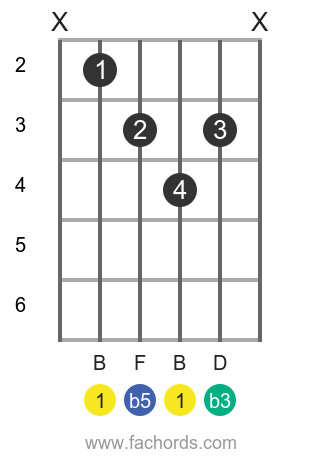 B dim position 1 guitar chord diagram
B dim position 1 guitar chord diagram
Unpacking the B Diminished Chord: Notes and Intervals
At its core, the B diminished chord is built from three fundamental notes: B, D, and F. These notes are derived from specific intervals, which define the chord’s characteristic sound. The intervals that construct the B diminished chord are:
- 1 (Root): B – This is the foundational note of the chord, giving it its name.
- ♭3 (Minor Third): D – A minor third interval above the root (B).
- ♭5 (Diminished Fifth): F – A diminished fifth interval above the root (B).
It’s these intervals – the minor third and the diminished fifth – that lend the diminished chord its tense and unresolved quality. To understand how these intervals are derived and how chords are built in general, exploring resources like our guitar music theory tutorial can be incredibly beneficial.
If you’re new to diminished chords, taking a step back to understand the broader family of these chords with our diminished guitar chords tutorial will provide a solid foundation before focusing specifically on the B diminished.
Understanding intervals is crucial for mastering guitar chords. Our fretboard intervals tutorial will guide you in identifying and playing intervals across the guitar neck, a skill that’s essential for learning any new chord, including the B diminished.
Furthermore, learning how chords are notated will enhance your musical literacy. Our guitar chords notation tutorial will equip you with the knowledge to read and write chord symbols, a valuable asset for any guitarist.
Visualizing the B Diminished Chord Shapes
Let’s explore practical ways to play the B diminished chord on your guitar. Below are several common positions, ranging in difficulty, allowing you to find a shape that suits your current skill level.
Position 1: Movable Shape
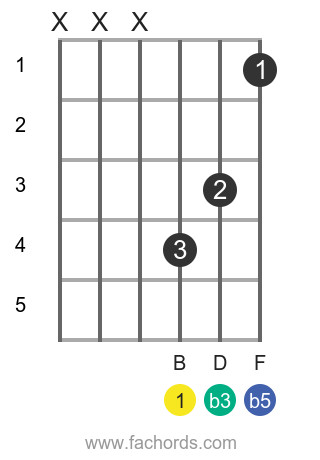 B dim position 5 guitar chord diagram
B dim position 5 guitar chord diagram
This first position is a movable shape, meaning you can slide it up and down the neck to create diminished chords with different root notes. Practice barring the first fret with your index finger to create a solid foundation for this shape.
Position 2: Movable Shape
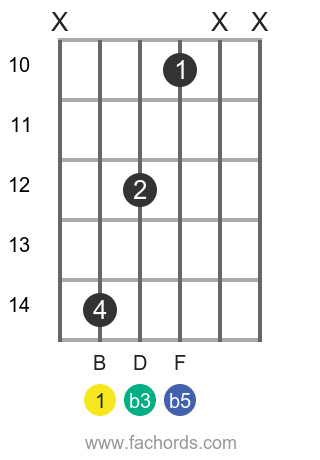 B dim position 6 guitar chord diagram
B dim position 6 guitar chord diagram
Another movable shape, this position provides a different voicing for the B diminished chord. Experiment with both position 1 and position 2 to find which sound and feel you prefer.
Position 3: Movable Shape
 B dim position 1 guitar chord diagram
B dim position 1 guitar chord diagram
This is the same diagram as the first image in the article. It is a common and relatively accessible diminished chord shape.
Position 4: Movable Shape
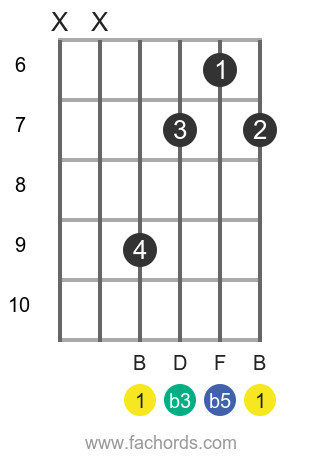 B dim position 2 guitar chord diagram
B dim position 2 guitar chord diagram
This position utilizes a smaller, four-string shape, making it potentially easier for beginners to grasp while still providing the full B diminished chord sound.
Position 5: Movable Shape
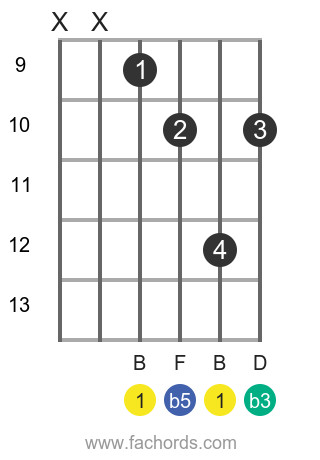 B dim position 3 guitar chord diagram
B dim position 3 guitar chord diagram
This final position offers yet another voicing and shape for the B diminished chord, encouraging you to explore different fingerings and sounds.
For a comprehensive library of guitar chords, including more positions for B diminished and other chords, visit our all guitar chords section. If you prefer a printable resource, our Free Guitar Chords Chart Pdf is available for download. Struggling with barre chords? Our Bar Chords Tips tutorial can provide valuable assistance. We also offer a accessible chords page with textual diagrams for easier reading.
Musical Context: Keys and Scales for B Diminished
Understanding where the B diminished chord fits within musical contexts is key to using it effectively. You’ll most commonly encounter the B diminished chord as the vii° chord in the C major key.
| Key | I | ii | iii | IV | V | vi | vii |
|---|---|---|---|---|---|---|---|
| C Major | C | Dm | Em | F | G | Am | B dim |
Similarly, in the relative minor key of A minor, B diminished appears as the ii° chord.
| Key | i | ii | III | iv | v | VI | VII |
|---|---|---|---|---|---|---|---|
| A Minor | Am | B dim | C | Dm | Em | F | G |
When improvising or composing over a B diminished chord, certain scales will harmonize particularly well. The locrian scale is a theoretical match due to its b3 and b5, mirroring the chord’s intervals, although it can create a dissonant sound.
More melodic options include:
- B Minor Blues Scale: The b5 interval in the B diminished chord aligns with the “blue note” in the minor blues scale, creating interesting bluesy diminished sounds.
- B Dorian #4 Scale: This scale offers a unique flavor over diminished chords.
- B Whole Tone Scale: The whole tone scale, with its symmetrical structure, works intriguingly over diminished chords. Explore our dedicated B Whole Tone Scale resource.
For a deeper dive into the relationship between scales and chords, and how to select the right scales for any chord, explore my ebook Scales Over Chords | Learn How To Play The Right Scales Over Any Chord.
Exploring B Diminished and Beyond
To further your exploration, here’s a fretboard map visualizing the notes of the B diminished chord across the guitar neck. This can aid in understanding the chord’s construction and finding further voicings.
[Fretboard map of B diminished chord tones, as in original article]
Expand your chord vocabulary by exploring other diminished chords with different root notes:
[List of diminished chords with links, as in original article]
Mastering the B diminished chord opens up a world of sonic possibilities on the guitar. Experiment with these positions, explore the suggested scales, and integrate this unique chord into your playing to add depth and sophistication to your musical expression. Happy playing!
